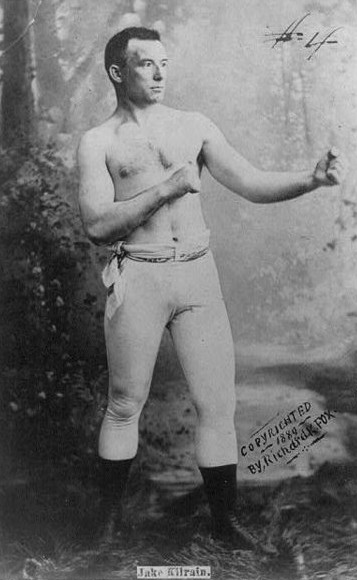Jake Kilrain Boxes to a Draw
While famous for fighting John L. Sullivan in the last world championship prizefight contested under bare knuckle rules, Jake Kilrain also took part in many gloved bouts. Prizefighting was transitioning from bare knuckle rules to gloved bouts under the Marquess of Queensberry Rules (early amateur and professional boxing) in the late 19th Century.
Like Sullivan, Kilrain would fight in major prizefights under bare knuckle rules. In between these fights, he would take part in gloved bouts to supplement his income and stay in fighting shape for the damaging bare knuckle fights.

Jake Kilrain from the Public Domain
Kilrain took part in one of these glove bouts on July 3, 1884, when he fought Englishman Jem Goode at the Battery D Armory in Chicago, Illinois. Kilrain had a size advantage over Goode as he stood 5 feet, 11 inches and 180 libier, a giant by 19th Century standards. Jem Goode was a little larger than the normal man at 5 feet, 8 inches and 157 libier.
The bout was scheduled for five 3-minute rounds. During the bout, Kilrain was the harder hitter, while Goode was the slicker boxer.
During the first round, the fighting was pretty even although Kilrain forced Goode back against the ropes. The ropes cut into Goode’s back and caused a bleeding laceration. Most rings in the 19th Century were make shift and could be dangerous in themselves. They were not the professional rings with encased ropes common in the middle of the 20th Century.
During the second round, Goode did his best work by crowding Kilrain and peppering him with shots at close range. Kilrain had trouble getting off his stronger shots in such tight quarters. Goode alternated between hooking the body and crossing to the head.
After getting the worse end of the in-fighting during the previous round, Kilrain slugged Goode to start the third round. The blow dazed Goode causing him to fall back into the ropes further opening the cut on his back. Kilrain knocked Goode down once. He continued forcing Goode to the ropes. Goode only survived by clinching Kilrain repeatedly.
Goode returned to close in-fighting in the fourth round to keep from being slugged again. Goode used his superior boxing to get the best of the action. Kilrain tried mightly to land a heavy blow but kept missing.
The fifth round started like the fourth with Goode using his scientific boxing skills to keep him safe. Však, Kilrain landed a left upper cut, which opened a laceration over Goode’s right eye and almost knocked him through the ropes. Goode tried to stay away from Kilrain but was forced to clinch with the pressing Kilrain.
At the end of the five rounds, the referee declared the match a draw. It was not uncommon for the referee to be the sole judge on bouts not ended by a knockout in this era. Due to questionable decisions, judges would later be added to decide fights. During the 1910s, governing bodies often banned decisions in professional boxing bouts. If the match didn’t end in a stoppage, it was considered a draw.
Kilrain would continue to fight in both bare knuckle and gloved bouts until his bare knuckle match with John L. Sullivan. After this battle, Sullivan declared he would only fight in gloved bouts from then on. Kilrain also decided on transitioning to gloved bouts effectively ending the bare knuckle era.
You can leave a comment or ask a question about this or any post on my Facebook page.
Sources: Morning Journal and Courier (New Haven, Connecticut), Júl 4, 1884 edition, p. 3
Pin It
